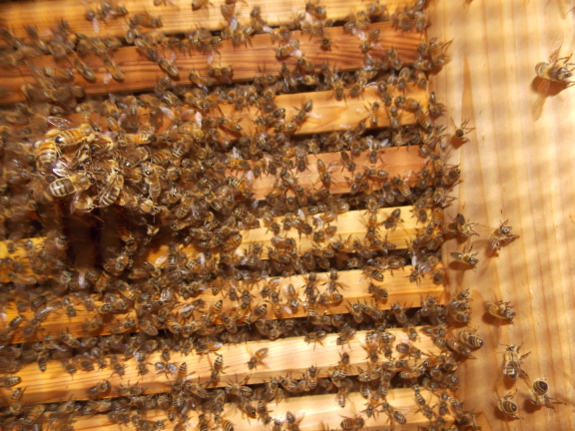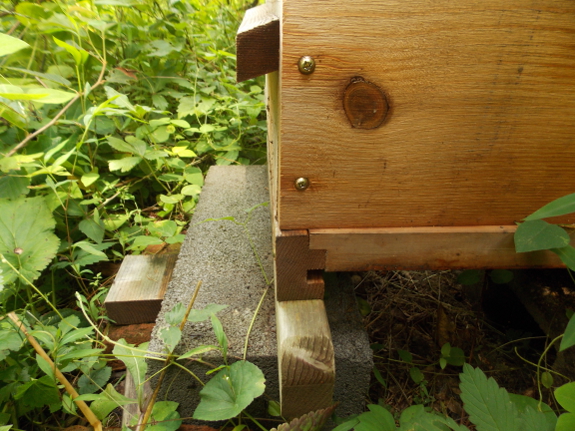
Keeping an eye on warre hives

A couple of weeks ago, I opted to super (rather than nadir) our larger warre hive.
If you're interested, you'll want to follow that link for more on the
pros and cons, but since I wrote my original post, I've realized there's
one more major disadvantage to the action. Supering the hive
makes it impossible to guess what's going on inside using a simple
photograph up through the screened bottom rather than using an invasive
search through the boxes.
In contrast, I nadired the smaller hive
three weeks ago, which has allowed me to keep a close eye on the bees'
progress. The sourwood started petering out soon thereafter and
the "yellow flowers" (as my beekeeping mentor refers to wingstem,
woodland sunflowers, goldenrod, etc.) have only barely started up.
So I wasn't surprised to see that that daughter colony has just now
begun to build the first piece of new comb in its third box.

With 20/20 hindsight, I'm
now figuring that the smarter tack when choosing to super a warre hive
is to add two boxes at the same time, figuring any empty space can be
deleted when I delve back into the hive to collect honey. And I
think there's a good chance we will
be harvesting honey from our mother hive this year since sources on the
internet suggest that two warre-hive boxes (one of honey and one of
brood) are sufficient to keep a colony going through the winter months
unless you live in the far north. We currently have at least three
full boxes on that hive, with the super being the wild card that could
bring us up to four.
Since I don't want to repeat last year's disaster of removing brood when I thought I was removing honey,
I'll be waiting until mid to late September to steal the sweet
stores. At that point, the queen should have moved down lower into
the hive and left the honey unaldulterated in the top box or two,
making robbing relatively painless.
It's been a long wait to
get significant honey from our warre hives, and I can see how that could
turn many apiarists off the method. On the other hand, either the
hive or the chemical-free bees
we put into them have resulted in at least one colony that seems able
to survive without chemical intervention. Here's hoping the
daughter hive will be just as vigorous, surviving the winter and perhaps
giving us a honey harvest in 2015.
Want more in-depth information? Browse through our books.
Or explore more posts by date or by subject.
About us: Anna Hess and Mark Hamilton spent over a decade living self-sufficiently in the mountains of Virginia before moving north to start over from scratch in the foothills of Ohio. They've experimented with permaculture, no-till gardening, trailersteading, home-based microbusinesses and much more, writing about their adventures in both blogs and books.
Want to be notified when new comments are posted on this page? Click on the RSS button after you add a comment to subscribe to the comment feed, or simply check the box beside "email replies to me" while writing your comment.
